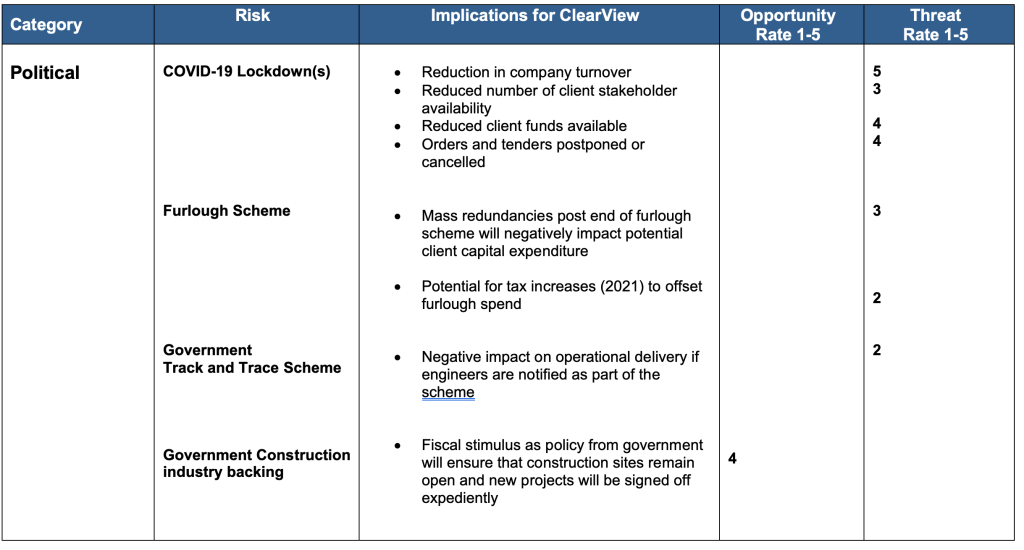What is a PESTLE Analysis? A PESTLE analysis is a tool to assess the external factors that could impact the profitability of your business. The acronym stands for: Political Economic Social Technological Legal Environmental factors. By analysing each of...
What is a PESTLE Analysis?

A PESTLE analysis is a tool to assess the external factors that could impact the profitability of your business. The acronym stands for:
Political
Economic
Social
Technological
Legal
Environmental factors.
By analysing each of these categories, companies can better understand the opportunities and threats in the market and make informed decisions about how to proceed.
This article will provide a simple guide to conducting a PESTLE analysis for your business and briefly introduce a SWOT analysis.
PESTLE Analysis and the Importance of Strategic Planning

As an experienced business leader, I have used PESTLE and other analysis tools, such as SWOT, with great success. For example, as a managing director of a company with a multi-million-pound turnover, strategic planning was one of the defining factors in my business success.
Failing to plan strategically is akin to hoping for the best and then wondering why the best did not happen. Planning to succeed makes it much more likely that your business will grow.
Below I have broken down the PESTLE analysis into steps to simplify the process.
Step 1: Identify the Political Factors

Political factors refer to the government’s policies and regulations that can impact your business. These include taxation policies, trade regulations, and employment law. To identify the political factors relevant to your business, you should consider the following questions:
What are the current government policies and regulations that impact your industry? Are there any upcoming changes to government policies that may impact your business? How do changes in government affect your business operations?For example, a business operating in the renewable energy sector must consider government policies related to renewable energy subsidies and carbon reduction targets.
Step 2: Identify the Economic Factors

Economic factors refer to the economic conditions of the market in which a business operates. They could include inflation, exchange rates, and interest rates. To identify the economic factors relevant to your business, you should consider the following questions:
What are the current economic conditions in the UK? How is the UK economy performing compared to other countries? Are there any upcoming economic changes that may impact your business?For example, a business operating in the tourism industry would need to consider the impact of currency fluctuations on international travel and the potential impact of a recession on consumer spending.
Step 3: Identify the Social Factors

Social factors refer to cultural and demographic trends that impact a business. This includes population demographics, consumer attitudes, and lifestyle trends. To identify the social factors relevant to your business, you should consider the following questions:
What are the current social trends and attitudes in the UK? How are population demographics changing? Are there any upcoming social changes that may impact your business? How will employees working from home impact your businessFor example, a business operating in the fashion industry would need to consider changing consumer attitudes towards sustainability and the impact of social media on consumer behaviour.
Step 4: Identify the Technological Factors

Technological factors should include the impact of new technologies on a business, such as automation, innovation, and digitalisation. To identify the technological factors relevant to your business, you should consider the following questions:
What new technologies are emerging in your industry? How is technology changing consumer behaviour? Are there any upcoming technological changes that may impact your business?For example, a business operating in the automotive industry would need to consider the impact of electric vehicles and autonomous driving technology on the industry.
Step 5: Identify the Legal Factors

Legal factors are the laws and regulations that can impact a business. They could include consumer protection laws, data protection laws, and health and safety regulations. To identify the legal aspects relevant to your business, you should consider the following questions:
What are the current legal regulations that impact your industry? Are there any upcoming changes to legal rules that may impact your business? How do changes in legal regulations affect your business operations?A business operating in the healthcare industry would need to consider changes to data protection laws and how this may impact their ability to use patient data.
Step 6: Identify the Environmental Factors

Environmental factors refer to the impact of the natural environment on a business, including climate change, resource depletion, and pollution. To identify the environmental factors relevant to your business, you should consider the following questions:
What are the current environmental trends and issues How is your industry contributing to environmental problems? Are there any upcoming ecological changes that may impact your business?If your business operates in the agriculture industry, consider the impact of climate change on crop yields and the environmental impact of farming practices.
Step 7: Analyse and Interpret the Data

After identifying the relevant factors for each category, it is essential to analyse and interpret the data better to understand the opportunities and threats in the market. This involves looking for patterns and trends across the different categories and considering how they may impact your business.
For example, a business operating in the retail industry may identify the following trends from their PESTLE analysis:
Political: Upcoming changes to import/export regulations may increase costs for importing goods. Economic: A recession may lead to reduced consumer spending on non-essential items. Social: Increasing demand for sustainable and ethical products. Technological: Growth of e-commerce and online shopping. Legal: Changes to data protection laws may impact customer data collection and marketing strategies. Environmental: Increasing pressure to reduce packaging waste and carbon emissions.Based on this analysis, the business may invest in sustainable packaging solutions and develop a more substantial online presence to adapt to the growth of e-commerce.
Step 8: Develop a Strategic Plan

For example, a business operating in the hospitality industry may develop the following strategic plan based on its PESTLE analysis:
Political: Build relationships with local government officials to stay informed about upcoming policy changes that may impact the business. Economic: Focus on developing cost-effective solutions to attract budget-conscious customers during a recession. Social: Develop a sustainable menu and increase marketing efforts around sustainable practices to appeal to environmentally conscious customers. Technological: Invest in a mobile app and online ordering system to adapt to the growth of e-commerce. Legal: Review data protection policies and procedures to ensure compliance with changing regulations. Environmental: Partner with local organisations to reduce food waste and promote sustainable practices.
The Benefits of PESTLE Analysis for Businesses
Hopefully, this blog has already shown you some benefits of conducting strategic planning and PESTLE analysis. In this section, I have listed the benefits of PESTLE in more detail. Read on to find out more.
Anticipate Changes in the Regulatory Environment
By conducting a PESTLE analysis, businesses can stay up-to-date with the latest changes in regulations and laws that may impact their industry. For example, if a new law is passed, that affects how businesses market their products or services; companies can adjust their marketing strategies accordingly.
Identify Emerging Trends
PESTLE analysis can help businesses identify emerging social, technological, and economic trends that may impact their industry. For example, if a new technology is gaining popularity among consumers, companies can adjust their product offerings to take advantage of this trend.
Identify New Business Opportunities
By analysing the external environment, businesses can identify new opportunities they may have overlooked. For example, if a new market is emerging in a particular region, businesses can adjust their market entry strategies to take advantage of this opportunity.
Reduce Business Risk
PESTLE analysis can help businesses identify potential risks and challenges impacting their operations. For example, if political unrest is brewing in a particular region, companies can take steps to mitigate the potential impact on their operations.
Help with Strategic Decision Making
Businesses can make more informed decisions about their operations by conducting a PESTLE analysis. Companies can develop more effective strategies and make better decisions by understanding the external factors that may impact their industry and organisation.
The Difference Between Internal and External Factors
Internal and external factors are equally important for strategic planning in business. Below are the key differences between the two:
Internal factors
These factors exist within the organisation, such as its culture, structure, employees, resources, and processes. Internal factors are primarily under the organisation’s control and can be influenced and managed by its leadership. Internal factors include the company’s financial resources, employee skills and expertise, organisational structure and culture, and the quality of its products or services.
External factors
We have discussed the external factors in detail as part of the PESTLE analysis content. However, the differences between internal and external factors must be understood.
The main differences between internal and external factors are that internal factors are usually under the organisation’s control, while external factors are outside its control. Internal factors can be influenced and managed by the organisation’s leadership, while external factors require the organisation to adapt and respond to changes in the external environment.
By understanding both types of elements, organisations can develop strategies that leverage their strengths, mitigate their weaknesses, and respond effectively to changes in the external environment.
When undertaking strategic planning, it is crucial to consider internal and external factors equally to create a comprehensive and effective plan that addresses the organisation’s strengths, weaknesses, opportunities, and threats.SWOT analysis is a good tool for identifying internal business factors. And this is discussed in more detail below.
What is SWOT Analysis?
SWOT analysis is a framework to analyse the internal factors that can impact a business. The acronym means Strengths, Weaknesses, Opportunities, and Threats. By examining these factors, businesses can better understand their current market position and identify improvement areas. For example, a company may have a strong brand reputation (strength). Still, it may need more modern technology (weakness) that could impact its ability to compete with other companies in the market.
Combined PESTLE and SWOT Analysis
By using PESTLE and SWOT analyses together, businesses can better understand their current position in the market and develop strategies to improve their performance. The external factors identified in the PESTLE analysis can inform the internal factors identified in the SWOT analysis and vice versa. For example, if a PESTLE analysis reveals significant technological advancements in the industry. In that case, a SWOT analysis can help identify internal weaknesses that must be addressed to keep up with those advancements. By using both analyses together, businesses can create a more effective and comprehensive strategy for success.
Summary of PESTLE Analysis
Conducting a PESTLE analysis is an essential step for any business looking to understand better the external factors impacting their operations. Businesses can develop a strategic plan that leverages opportunities and mitigates threats by identifying and analysing PESTLE factors. It is important to regularly review the PESTLE analysis to ensure that the strategic plan remains relevant and effective in the ever-changing business environment.
If you need support with strategic planning and want to hit your business goals for this year, contact Strategic Goal Management. We accelerate your business growth!
The post PESTLE Analysis for Your Business appeared first on Strategic Goal Management.


